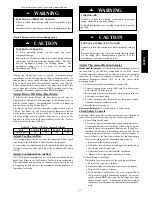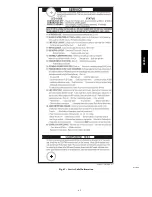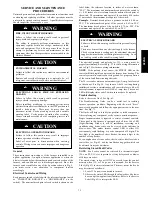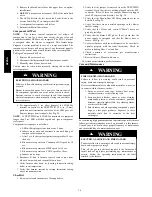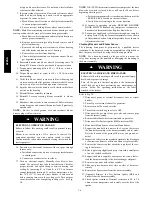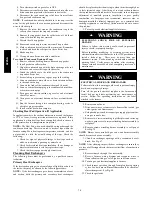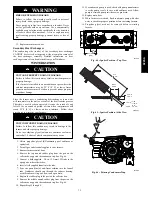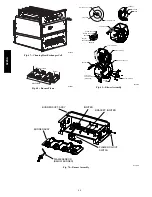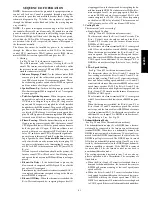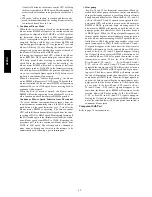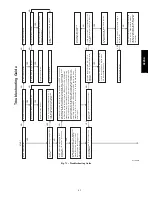
81
SEQUENCE OF OPERATION
NOTE
: Furnace control must be grounded for proper operation or
control will lock out. Control is grounded through green/yellow
wire routed to gas valve and manifold bracket screw. Using the
schematic diagram in Fig. 72, follow the sequence of operation
through the different modes. Read and follow the wiring diagram
very carefully.
NOTE
: If a power interruption occurs during a call for heat (W),
the control will start a 90--sec blower--only ON period two sec after
power is restored, if the thermostat is still calling for gas heating.
The Amber LED light will flash code 12 during the 90--sec period,
after which the LED will be ON continuous, as long as no faults
are detected. After the 90--sec period, the furnace will respond to
the thermostat normally.
The blower door must be installed for power to be conducted
through the blower door interlock switch ILK to the furnace
control CPU, transformer TRAN, inducer motor IDM, blower
motor BLWM, hot--surface igniter HSI, and gas valve GV.
1. Heating
See Fig. 38 and 39 for thermostat connections.)
The wall thermostat “calls for heat,” closing the R--to--W
circuit. The furnace control performs a self--check, verifies
the pressure switch contacts LPS and HPS are open, and
starts the inducer motor IDM.
a.
Inducer Prepurge Period
-- As the inducer motor IDM
comes up to speed, the collector box pressure switch con-
tacts LPS close to begin a 15--sec prepurge period. The in-
ducer housing pressure switch contacts HPS are ignored
until one minute after the gas valve closes.
b.
Igniter Warm--Up
-- At the end of the prepurge period, the
Hot--Surface igniter HSI is energized for a 17--sec igniter
warm--up period.
c.
Trial--for--Ignition Sequence
-- When the igniter warm--
up period is completed, the main gas valve relay contacts
GVR close to energize the gas valve GV, the gas valve
opens, and 24 vac power is supplied for a field--installed
humidifier at the HUM terminal. The gas valve GV permits
gas flow to the burners where it is ignited by the HSI. Five
sec after the GVR closes, a 2--sec flame proving period be-
gins. The HSI igniter will remain energized until the flame
is sensed or until the 2--sec flame proving period begins.
d.
Flame--Proving
-- When the burner flame is proved at the
flame--proving sensor electrode FSE, the furnace control
CPU begins the blower--ON delay period and continues to
hold the gas valve GV open. If the burner flame is not
proved within two sec, the control CPU will close the gas
valve GV, and the control CPU will repeat the ignition se-
quence for up to three more Trials--For--Ignition before go-
ing to Ignition--Lockout.
Lockout will be reset
automati-
cally after three hours or by momentarily interrupting 115
vac power to the furnace, or by interrupting 24 vac power
at SEC1 or SEC2 to the furnace control CPU (not at W, G,
R, etc.).
If flame is proved when flame should not be present, the
furnace control CPU will lock out of Gas--Heating mode
and operate the inducer motor IDM until flame is no longer
proved.
e.
Blower--On Delay
-- If the burner flame is proven, the
blower motor is energized on HEAT speed 25 sec after the
gas valve GV is energized.
Simultaneously, the electronic air cleaner terminal EAC--1
is energized and remains energized as long as the blower
motor BLWM is energized.
f.
Blower--Off Delay
-- When the thermostat is satisfied, the
R--to--W circuit is opened, de--energizing the gas valve GV,
stopping gas flow to the burners, and de--energizing the hu-
midifier terminal HUM. The inducer motor IDM will re-
main energized for a 15--sec post--purge period. The blow-
er motor BLWM and air cleaner terminal EAC--1 will
remain energized for 90, 120, 150, or 180 sec (depending
on the blower--OFF delay selection). The furnace control
CPU is factory--set for a 120--sec blower--OFF delay.
2.
Cooling Mode
The thermostat “calls for cooling.”
a. Single--Speed Cooling
See Fig. 38 and 39 for thermostat connections)
The thermostat closes the R--to--G--and--Y circuits. The
R--to-- Y circuit starts the outdoor unit, and the R--to--
G--and--Y/Y2 circuits start the furnace blower motor
BLWM on COOL speed.
The electronic air cleaner terminal EAC--1 is energized
with 115 vac when the blower motor BLWM is operating.
When the thermostat is satisfied, the R--to--G--and--Y cir-
cuits are opened. The outdoor unit will stop, and the fur-
nace blower motor BLWM will continue operating on the
COOL speed for an additional 90 sec. Jumper Y/Y2 to
DHUM to reduce the cooling off--delay to 5 sec. See Fig.
38.
b.
Two--Speed Cooling
See Fig. 38 and 39 for thermostat connections.)
The thermostat closes the R--to--G--and--Y1 circuits for
low--cooling or closes the R--to--G--and--Y1--and--Y2 cir-
cuits for high--cooling. The R--to--Y1 circuit starts the out-
door unit on low--cooling speed, and the R--to--G--and--Y1
circuit starts the furnace blower motor BLWM on low--cool
speed (same speed as FAN). The R--to--Y1--and--Y2 cir-
cuits start the outdoor unit on high--cooling speed, and the
R--to--G and-- Y/Y2 circuits start the furnace blower motor
BLWM on COOL speed.
The electronic air cleaner terminal EAC--1 is energized
with 115 vac whenever the blower motor BLWM is operat-
ing.
When the thermostat is satisfied, the R--to--G--and--Y1 or
R--to--G--and--Y1 and Y2 circuits are opened. The outdoor
unit stops, and the furnace blower BLWM and electronic
air cleaner terminal EAC--1 will remain energized for an
additional 90 sec. Jumper Y1 to DHUM to reduce the cool-
ing off--delay to 5 sec. See Fig. 38.
3.
Dehumidification Mode
See Fig. 38 and 39 for Thermidistat connections.)
The dehumidification output, D or DHUM from a thermo-
stat should be connected to the furnace control thermostat
terminal DHUM. When there is a dehumidify demand, the
DHUM input is activated, which means 24 vac signal is re-
moved from the DHUM input terminal. In other words, the
DHUM input logic is reversed. The DHUM input is turned
ON when no dehumidify demand exists. Once 24 vac is de-
tected by the furnace control on the DHUM input, dehumid-
ification capability is activated. If the DHUM is removed
for more than 48 hr, the furnace control reverts back to
non--dehumidification mode.
The cooling operation described in item 2. above also ap-
plies to operation with a Thermidistat. The exceptions are
listed below:
a. When the R--to--G--and--Y1 circuit is closed and there is a
demand for dehumidification, the furnace blower motor
BLWM will continue running at low--cool speed (same
speed as FAN).
b. When the R--to--G--and--Y/Y2 circuit is closed and there
is a demand for dehumidification, the furnace blower mo-
tor BLWM will drop the blower speed from COOL to
HEAT for a maximum of 10 minutes before reverting back
to COOL speed. If there is still a demand for dehumidifica-
922SA

